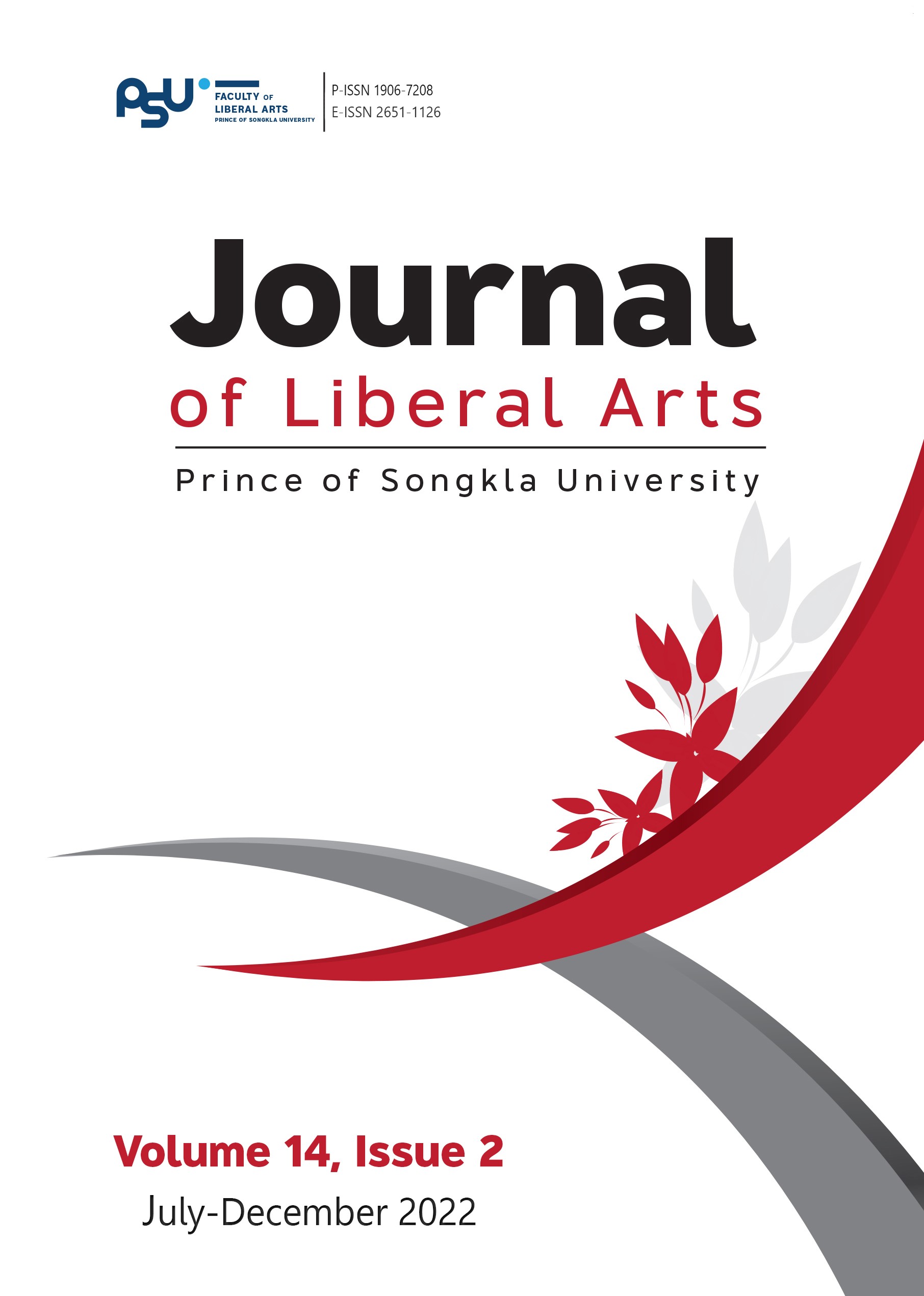Tone Sandhi in Lahu Nyi
DOI:
https://doi.org/10.14456/jlapsu.2022.18Keywords:
tones, tone sandhi, Lahu Nyi, acousticsAbstract
This study was conducted to determine if tone sandhi exists in Lahu Nyi. Lahu Nyi, a 7-tone language, is one of the Lahu dialects, a member of the Central Loloish branch of the Lolo-Burmese subgroup of Tibeto-Burman languages (Matisoff, 2003). Tone sandhi, a phenomenon occurring in some tone languages, refers to a phonological change from one tone to the other triggered by tone of adajacent words or morphemes. A word list specifically designed to elicit tone sandhi data was presented to research participants in a picture naming task. Five native speakers of Lahu Nyi who were residents of Chiang Doa District, Chiang Mai Province, Thailand, produced the target words in a soundproof room. Their production was transcribed and submitted to a detailed acoustic analysis. The obtained acoustic values such as F0 patterns and duration of the targeted vowel portion of a monosyllabic word and word in targeted context were compared. The results showed that tone sandhi occurs in three experimental conditions: compounding, color naming and causativisation (that is “to feed” is a causative verb derived from a transitive verb “to eat”). In compounding, the pattern of tone change from the citation value to new word is mid to high; in color naming, from mid to high-rising; and in causativisation, from high to low. These results confirmed the presence of tone sandhi in Lahu Nyi and the similarity between Lahu Na and Lahu Nyi dialects.
References
Abramson, A.S. (1979). The coaticulation of tones: An acoustic study of Thai. In Kullavanijaya, K. Tingsabadh & T. Luangthongkum (Eds.), Studies of Tai and Man-Khmer phonetics in honour of Eugenie J. A. Henderson (pp. 1-9). Chulalongkorn University Press.
Bradley, D. (1979). Lahu Dialects. Australian National University Press.
Bradley. D. (2003). Lisu. In G. Thurgood & R. J. LaPolla (Eds.), The Sino-Tibetan languages (pp. 222-235). Routledge.
Boersma, P., & Weenink, D. (2022). Praat: Doing phonetics by computer [Computer program]. Version 6.2.23, retrieved 8 October 2022 from http://www.praat.org/
Chen, M. Y. (2000). Tone sandhi: Patterns across Chinese dialects (Vol. 92). Cambridge University Press.
Chao, Y. R. (1930). A system of tone-letters. Le Maitre Phonétique, 45, 24-27.
Ethnologue. (2018, April). Lahu. https://www.ethnologue.com/ language/lhu.
Gandour, J., Potisuk, S., Dechongkit, S., & Ponglorpisit, S. (1992). Tonal coarticulation in Thai disyllabic utterances: A preliminary study. Linguistics of the Tibeto-Burman Area, 15(1), 93-110.
Hansson, I-L. (2003). Akha. In G. Thurgood & R. J. LaPolla (Eds.), The Sino-Tibetan languages (pp. 885-901). Routledge.
Inter Mountain People’s Education and Culture in Thailand Association. (2015). In Minutes of IMPECT committee meeting, November 24, 2015. IMPECT Office.
Jangjamras, J., Wayland, R., & Chen, S. (2019). Acoustic analysis of Lahu Nyi tone system. In S. Calhoun, P. Escudero, M. Tabain & P. Warren (Eds.), Proceedings of the 19th International Congress of Phonetic Sciences, Melbourne, Australia 2019 (pp. 3882-3886). Australasian Speech Science and Technology Association Inc.
Kirby, J., & Brunelle, M. (2017). Southeast Asian tone in areal perspective. In R. Hickey (Ed.), The Cambridge handbook of areal linguistics (p. I). Cambridge University Press.
Ladyxoxo.com. (n.d.). Carrying boy [Photograph]. https://www.ladyxoxo.com/upload/img/dc/7e313cadc.jpg
Lewis, P. (1986). Lahu-English-Thai dictionary. Darnsutha Press.
Matisoff, J. A. (2003). Lahu. In G. Thurgood & R.J. LaPolla (Eds.), The Sino-Tibetan languages (pp. 918-931). Routledge.
Matisoff, James A. (2006). English-Lahu lexicon. University of California Press.
Potisuk, S., Gandour, J., & Harper, M. (1997). Contextual variations in trisyllabic sequences of Thai tones. Phonetica, 54(1), 22-42
Rose, P. (1990). Acoustics and phonology of complex tone sandhi: An analysis of disyllabic lexical tone sandhi in the Zhenhai variety of Wu Chinese. Phonetica, 4(7), 1-35.
Sirisai, S. (1986). The phonological description of Lahu Nyi language spoken in Chayi village, Pa-tung sub-district Meachan district, Chiengrai province. [Unpublished master’s thesis]. Mahidol University.
Tu, J. Y., & Chien, Y. F. (2021). The role of categorical perception and acoustic details in the processing of Mandarin tonal alternations in contexts: An eye-tracking study. Frontiers in Psychology, 12, 1-14.
Waite, G. (n.d.). Carrying [Photograph]. Pinterest.https://www.pinterest.com/pin/645070346610003737/.jpg
Walker, A. R. (1980). The production and use of opium in the northern Thai uplands: An introduction. Contemporary Southeast Asia, 2(2), 135–154. http://www.jstor.org/stable/25797612
Xu, Y. (1997). Contextual tonal variations in Mandarin. Journal of Phonetics, 25(1), 61-83.
Xu, Y. (2013). Prosody Pro. http://www.homepages.ucl.ac.uk/~uclyyix/ProsodyPro/
Zhang, J. (2014). Tones, tonal phonology, and tone sandhi. In C.-T.J. Huang, Y.-H.A. Li, & A. Simpson (Eds.), Chinese linguistics (pp. 443–464). John Wiley & Sons.
Zhang, J., & Lai, Y.-W. (2010). Testing the role of phonetic knowledge in Mandarin tone sandhi. Phonology, 27, 153-201.
Zhang, J., & Liu, J. (2011). Tone sandhi and tonal coarticulation in Tianjin Chinese. Phonetica, 68, 161-191.
Zhu, X., & Wang, C. (2015). Tone. In S-Y.W Wang & C. Sun (Eds.), The Oxford handbook of Chinese linguistics (pp. 503 -516). Oxford University Press.
Downloads
Published
How to Cite
Issue
Section
License
Copyright (c) 2022 ๋Jirapat Jangjamras, Ratree Wayland

This work is licensed under a Creative Commons Attribution-NonCommercial-NoDerivatives 4.0 International License.
The authors retain the copyright to their article but the Journal of Liberal Arts, Prince of Songkla University reserves the exclusive rights to first publication.






